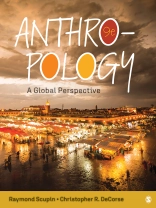Now with SAGE Publishing!
Using state-of-the-art research, Anthropology: A Global Perspective introduces students to the four core subfields of anthropology and applied anthropology. Integrating material from each subfield, this comprehensive text is founded on four essential themes: the diversity of human societies; the similarities that tie all humans together; the interconnections between the sciences and humanities; and a new theme addressing psychological essentialism. Authors Raymond Scupin and Christopher R. De Corse demonstrate how anthropologists use research techniques and methods to help solve practical problems and show students how anthropology is relevant to improving human societies. This supportive textbook is grounded in the belief that an enhanced global awareness is essential for people preparing to take their place in the fast-paced, interconnected world of the twenty-first century. The extensively revised Ninth Edition includes a new chapter on gender and sexuality, features a dramatically new look with new photos and figures, and has been updated to reflect the most recent findings in the field.
This title is accompanied by a complete teaching and learning package.
表中的内容
Part 1: Basic Concepts in Anthropology
Chapter 1: Introduction to Anthropology
Anthropology: The Four Subfields
Holistic Anthropology, Interdisciplinary Research, and a Global Perspective
Anthropological Explanations
Humanistic-Interpretive Approaches in Anthropology
Why Study Anthropology?
Summary and Review of Learning Objectives/Key Terms
Chapter 2: The Record of the Past
Answering Questions
Paleoanthropological Study
Archaeological Research
Locating Sites and Fossil Localities
Archaeological Excavation
Dating Methods
Interpreting the Past
Summary and Review of Learning Objectives/Key Terms
Chapter 3: Evolution
Cosmologies and Human Origins
The Scientific Revolution
Theory of Evolution
Principles of Inheritance
Inheritance and Molecular Genetics
Population Genetics and Evolution
How Do New Species Originate?
The Evolution of Life
Summary and Review of Learning Objectives/Key Terms
Part 2: Biological Anthropology
Chapter 4: The Primates
Primate Characteristics
Classification of Primates
Evolution of the Primate Order
Primate Behavior
The Human Primate
Summary and Review of Learning Objectives/Key Terms
Chapter 5: Hominin Evolution
Trends in Hominin Evolution
Fossil Evidence for Hominin Evolution
Interpreting the Fossil Record
From Homo erectus to Homo sapiens
Archaic and Anatomically Modern Homo sapiens
Genetic Data and Hominin Phylogeny
Summary and Review of Learning Objectives/Key Terms
Chapter 6: Human Variation
Sources of Human Variation
Adaptive Aspects of Human Variation
Effects of the Physical Environment
Cultural Factors in Human Evolution
The Concept of Race
Heredity and Intelligence
Current Approaches to Human Variation
Summary and Review of Learning Objectives/Key Terms
Part 3: Archaeology
Chapter 7: The Paleolithic
Lifestyles of the Earliest Hominins
The Life and Times of Genus Homo
The Middle Paleolithic
Modern Homo sapiens and Their Cultures
The Migration of Upper Paleolithic Humans
Summary and Review of Learning Objectives/Key Terms
Chapter 8: The Origins of Domestication and Settled Life
The End of the Paleolithic: Changes in Climate and Culture
The Neolithic: Origins of Food Production
Why Did Domestication Occur?
Domestication in Different Regions of the World
Consequences of Domestication
Summary and Review of Learning Objectives/Key Terms
Chapter 9: The Rise of the State and Complex Society
The State and Civilization
Studying Complex Societies
Why Did States Form?
States in Different World Areas
The Collapse of State Societies
Summary and Review of Learning Objectives/Key Terms
Part 4: Basic Concepts of Culture and Society
Chapter 10: Culture
The Characteristics of Culture
Culture is Learned
Culture is Shared
Aspects of Culture
Cultural Diversity
Cultural Universals
Summary and Review of Learning Objectives/Key Terms
Chapter 11: The Process of Enculturation: Psychological and Cognitive Anthropology
Biology versus Culture
Instincts and Human Nature
Enculturation: Culture and Personality
Psychoanalytic Approaches in Anthropology
Enculturation and Cognition
Cognitive Anthropology
Evolutionary Psychology
Enculturation and Emotions
Neuroanthropology
The Limits of Enculturation
Summary and Review of Learning Objectives/Key Terms
Chapter 12: Language
Nonhuman Animal Communication
Animal Communication versus Human Language
The Evolution of Language
The Structure of Language
Language Acquisition
Language, Thought, and Culture
Historical Linguistics
Sociolinguistics
Nonverbal Communication
Summary and Review of Learning Objectives/Key Terms
Chapter 13: Anthropological Explanations
Nineteenth-Century Evolutionism
Diffusionism
Historical Particularism
Functionalism
Twentieth-Century Evolutionism
Marxist Anthropology
Symbolic Anthropology: A Humanistic Method of Inquiry
Feminist Anthropology
Postmodernism and Anthropology
Twenty-First-Century Cultural Evolution
Summary and Review of Learning Objectives/Key Terms
Chapter 14: Analyzing Sociocultural Systems
Ethnographic Fieldwork
Ethnographic Research and Strategies
Ethics in Anthropological Research
Analysis of Ethnographic Data
Sociocultural Evolution: A Contemporary Model
Types of Sociocultural Systems
Cross-Cultural Research
Summary and Review of Learning Objectives/Key Terms
Part 5: Studying Different Societies
Chapter 15: Environment, Subsistence, and Demography
Subsistence and the Physical Environment
Demography
Modern Foraging Environments and Subsistence
Demographic Conditions for Foragers
Environment and Subsistence for Horticulturalists and Pastoralists
Demographics and Settlement
Environment, Subsistence, and Demography for Chiefdoms
Environment and Demography in Agricultural States
Environment and Energy Use in Industrial and Postindustrial Societies
Demographic Change
Summary and Review of Learning Objectives/Key Terms
Chapter 16: Technology and Economics
Anthropological Explanations of Technology
Anthropology and Economics
Technology in Foraging Societies
Economics in Foraging Societies
Technology Among Horticulturalists and Pastoralists
Economics in Horticulturalist and Pastoralist Societies
Technology in Chiefdoms
Economics in Chiefdoms
Technology in Agricultural States
Economics in Agricultural States
Technology and Economic Change in Industrial and Postindustrial Societies
Summary and Review of Learning Objectives/Key Terms
Chapter 17: Social Structure, the Family, Marriage, and Age
Social Structure
Understanding Incest Avoidance and the Incest Taboo
Age
Social Structure in Hunter-Gatherer Societies
Social Structure in Tribes
Social Structure in Chiefdoms
Social Structure in Agricultural States
Social Stratification in Agricultural States
Social Structure in Industrial and Postindustrial Societies
Social Stratification in Industrial and Postindustrial Societies
Summary and Review of Learning Objectives/Key Terms
Chapter 18: Gender and Sexuality
The Complexities of Sex
The Complexities of Gender
Transgender and LGBTQ Individuals
Gender in Foraging Societies
Gender in Tribal Societies
Patriarchy in Tribal Societies
Gender in Chiefdom Societies
Gender in Agricultural States
Gender in Industrial and Postindustrial Societies
Gender in Latin America, Africa, the Middle East, and Asia
Sexuality in Different Societies
Summary and Review of Learning Objectives/Key Terms
Chapter 19: Politics, Warfare, and Law
Politics, Warfare, and Law
Political Organization in Foraging Societies
Warfare and Violence in Foraging Societies
Political Organization in Horticulturalist and Pastoralist Tribes
Explaining Tribal Warfare
Political Authority in Chiefdoms
The Evolution of Chiefdoms
Politics in Agricultural States
Political Organization in Industrial and Postindustrial States
Warfare and Industrial Technology
Summary and Review of Learning Objectives/Key Terms
Chapter 20: Religion and Aesthetics
Religion
Myths and Rituals
Rites of Passage
Cognition and Religion
Aesthetics: Art and Music
Religion among Foragers
Art, Music, and Religion among Foragers
Religion among Horticulturalists and Pastoralists
Religion in Chiefdoms
Art, Architecture, and Music in Chiefdoms
Religion in Agricultural States
Art, Architecture, and Music in Agricultural States
Religion and Secularization in Industrial and Postindustrial Societies
Art and Music in Industrial and Postindustrial Societies
Summary and Review of Learning Objectives/Key Terms
Part 6: Consequences of Globalization
Chapter 21: Globalization, Culture, and Indigenous Societies
Globalization: A Contested Term
Globalization: Technological and Economic Trends
Globalization: General Theoretical Approaches
Anthropological Analysis and Globalization
Globalization, Politics, and Culture
Globalization and Indigenous Peoples
Forms of Resistance among Indigenous Peoples
Pro- and Anti-Globalization: An Anthropological Contribution
Summary and Review of Learning Objectives/Key Terms
Chapter 22: Globalization, Colonialism, and Postcolonialism
Globalization and Colonialism
Consequences of Globalization and Colonialism
Political Changes: Independence and Nationalist Movements
Uneven Economic Development
Ethnographic Studies
Social Structure in Postcolonial Societies
Patterns of Ethnicity
Summary and Review of Learning Objectives/Key Terms
Chapter 23: Ethnicity
Race, Racism, and Culture
The Cultural and Social Significance of Race
Ethnicity
Anthropological Perspectives on Ethnicity
Patterns of Ethnic Relations
Ethnic Relations in the United States
Ethnonationalism
Summary and Review of Learning Objectives/Key Terms
Chapter 24: Applied Anthropology
The Roles of the Applied Anthropologist
Biological Anthropology
Medical Anthropology
Cultural Resource Management: Applied Archaeology
Who Owns the Past?
Applied Cultural Anthropology
Applied Anthropology, Climate Change, and Sustainability
Applied Anthropology and Human Rights
Summary and Review of Learning Objectives/Key Terms
关于作者
Christopher R. De Corse is a distinguished professor and chair of the Department of Anthropology in the Maxwell School of Citizenship and Public Affairs, Syracuse University. He received his B.A. in anthropology with a minor in history from the University of New Hampshire, before completing his M.A. and Ph.D. degrees in archaeology at the University of California—Los Angeles. His research interests include African archaeology and history, general anthropology, and archaeology in popular culture. Dr. De Corse has excavated a variety of prehistoric and historic period sites in the United States, the Caribbean, and Africa, but his primary area of research has been in the archaeology, history, and ethnography of Africa. Dr. De Corse has taught archaeology and general anthropology in undergraduate and graduate programs at the University of Ghana, Indiana University of Pennsylvania, and Syracuse University. His academic honors and awards include: the Daniel Patrick Moynihan Award for Outstanding Teaching, Research and Service; the William Wasserstrom Award for Excellence in Graduate Teaching; and the Syracuse University Excellence in Graduate Education Faculty Recognition Award. Dr. De Corse is particularly interested in making archaeology more accessible to general audiences. In addition to the single-authored physical anthropology and archaeology textbook The Record of the Past: An Introduction to Physical Anthropology and Archaeology, he coauthored with Brian Fagan, the eleventh edition of In the Beginning: An Introduction to Archaeology. He is currently completing a book examining the presentation of archaeologists and archaeology in popular culture. Dr. De Corse’s academic publications include more than sixty articles, book chapters, and research notes in a variety of publications, including The African Archaeological Review, Historical New Hampshire, Historical Archaeology, the Journal of African Archaeology, and Slavery and Abolition. Volumes on his research in Africa include An Archaeology of Elmina: Africans and Europeans on the Gold Coast 1400–1900 (Smithsonian Institution Press, 2001) and the edited volume, West Africa during the Atlantic Slave Trade: Archaeological Perspectives (Bloomsbury, 2016). His most recent books include Fringe Archaeology: Unraveling the Mysteries of the Past (Cognella 2025), Anthropology: A Global Perspective, 9th Edition (with Raymond Scupin, SAGE 2021), and the edited volumes that deal with Europe’s entanglements with the non-Western World: Power, Political Economy, and Historical Landscapes of the Modern World: Interdisciplinary Perspectives (Fernand Braudel Center Studies in Historical Social Science, SUNY Press, 2019) and British Forts and Their Communities: Archaeological and Historical Perspectives, with Zachary J. M. Beier (University Press of Florida, 2018).












